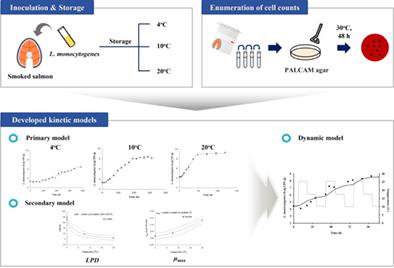当前位置:
X-MOL 学术
›
J. Food Saf.
›
论文详情
Our official English website, www.x-mol.net, welcomes your
feedback! (Note: you will need to create a separate account there.)
Dynamic model to describe kinetic behavior of Listeria monocytogenes in smoked salmon
Journal of Food Safety ( IF 1.9 ) Pub Date : 2021-08-20 , DOI: 10.1111/jfs.12925 Joohyun Kang 1 , Hyemin Oh 2 , Yewon Lee 1 , Heeyoung Lee 3 , Soomin Lee 2 , Sejeong Kim 2 , Jimyeong Ha 2 , Yukyung Choi 2 , Yujin Kim 1 , Yeongeun Seo 1 , Eunyoung Park 1 , Hyunjung Kim 4 , Yohan Yoon 1, 2
Journal of Food Safety ( IF 1.9 ) Pub Date : 2021-08-20 , DOI: 10.1111/jfs.12925 Joohyun Kang 1 , Hyemin Oh 2 , Yewon Lee 1 , Heeyoung Lee 3 , Soomin Lee 2 , Sejeong Kim 2 , Jimyeong Ha 2 , Yukyung Choi 2 , Yujin Kim 1 , Yeongeun Seo 1 , Eunyoung Park 1 , Hyunjung Kim 4 , Yohan Yoon 1, 2
Affiliation

|
In this study, the dynamic model was developed to describe cell counts of Listeria monocytogenes in smoked salmon under distribution conditions. A 9-strain mixture of L. monocytogenes was inoculated in smoked salmon at 3–4 Log CFU/g. The inoculated samples were stored at 4°C, 10°C, and 20°C for up to 16 days, and the bacterial cell counts were enumerated on PALCAM agar. The Baranyi model was fitted to the L. monocytogenes cell counts to calculate the lag phase duration (LPD; hr) and maximum growth rate (μmax; Log CFU/g/hr). LPD was 74.22 hr at 4°C, and the value was rapidly decreased to 4.84 hr at 20°C as temperature increased. μmax ranged from 0.01 to 0.13 Log CFU/g/hr, depending on the storage temperature. The kinetic parameters were fitted with secondary models as a function of temperature. Cell counts predicted by the developed model were compared with the predicted cell counts obtained at 8°C and 15°C, and the differences between predicted and observed cell counts were indicated by root mean square error (RMSE). The dynamic model was then developed with the kinetic parameters derived from the secondary model and simulated the L. monocytogenes growth. RMSE (0.368) indicates that the model performance was appropriate. These results suggest that the developed kinetic models can be useful in predicting the fates of L. monocytogenes in smoked salmon under the dynamic conditions of storage temperature and time.
中文翻译:

描述烟熏三文鱼中单核细胞增生李斯特菌动力学行为的动态模型
在本研究中,开发了动态模型来描述分布条件下熏鲑鱼中单核细胞增生李斯特菌的细胞计数。将单核细胞增生李斯特菌的9 株混合物以 3–4 Log CFU/g 接种到熏鲑鱼中。接种的样品在 4°C、10°C 和 20°C 下储存最多 16 天,并在 PALCAM 琼脂上计算细菌细胞计数。该Baranyi模型拟合到单增李斯特菌细胞计数来计算滞后阶段持续时间(LPD ; HR)和最大生长速率(μ最大;登录CFU /克/小时)。LPD在 4°C 下为 74.22 小时,随着温度升高,该值在 20°C 下迅速降低至 4.84 小时。μ最大值范围从 0.01 到 0.13 Log CFU/g/hr,具体取决于存储温度。动力学参数与作为温度的函数的二级模型相匹配。将开发的模型预测的细胞计数与在 8°C 和 15°C 下获得的预测细胞计数进行比较,预测和观察到的细胞计数之间的差异用均方根误差 ( RMSE ) 表示。然后使用源自二级模型的动力学参数开发动态模型并模拟单核细胞增生李斯特氏菌的生长。RMSE (0.368) 表明模型性能合适。这些结果表明,开发的动力学模型可用于预测单核细胞增生李斯特氏菌的命运 烟熏三文鱼在储存温度和时间的动态条件下。
更新日期:2021-10-08
中文翻译:

描述烟熏三文鱼中单核细胞增生李斯特菌动力学行为的动态模型
在本研究中,开发了动态模型来描述分布条件下熏鲑鱼中单核细胞增生李斯特菌的细胞计数。将单核细胞增生李斯特菌的9 株混合物以 3–4 Log CFU/g 接种到熏鲑鱼中。接种的样品在 4°C、10°C 和 20°C 下储存最多 16 天,并在 PALCAM 琼脂上计算细菌细胞计数。该Baranyi模型拟合到单增李斯特菌细胞计数来计算滞后阶段持续时间(LPD ; HR)和最大生长速率(μ最大;登录CFU /克/小时)。LPD在 4°C 下为 74.22 小时,随着温度升高,该值在 20°C 下迅速降低至 4.84 小时。μ最大值范围从 0.01 到 0.13 Log CFU/g/hr,具体取决于存储温度。动力学参数与作为温度的函数的二级模型相匹配。将开发的模型预测的细胞计数与在 8°C 和 15°C 下获得的预测细胞计数进行比较,预测和观察到的细胞计数之间的差异用均方根误差 ( RMSE ) 表示。然后使用源自二级模型的动力学参数开发动态模型并模拟单核细胞增生李斯特氏菌的生长。RMSE (0.368) 表明模型性能合适。这些结果表明,开发的动力学模型可用于预测单核细胞增生李斯特氏菌的命运 烟熏三文鱼在储存温度和时间的动态条件下。










































 京公网安备 11010802027423号
京公网安备 11010802027423号